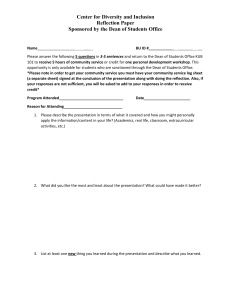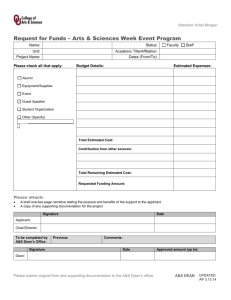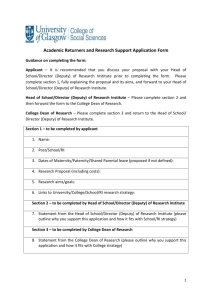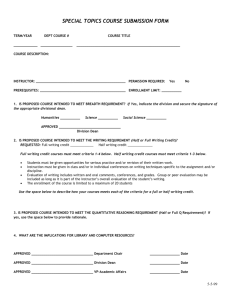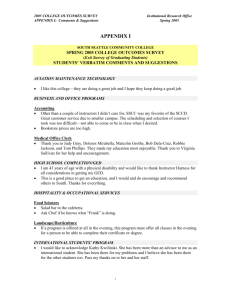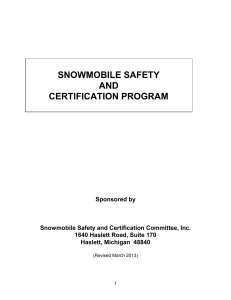SCHOOL PROCESS FOR RESPONDING TO STUDENT
advertisement
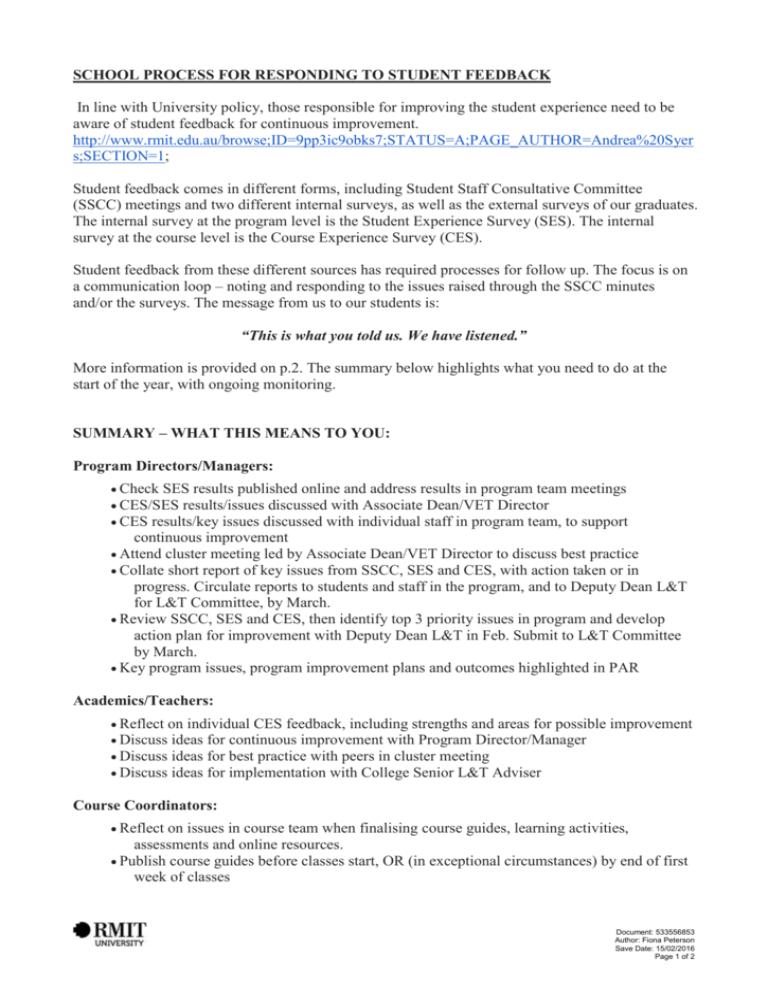
SCHOOL PROCESS FOR RESPONDING TO STUDENT FEEDBACK In line with University policy, those responsible for improving the student experience need to be aware of student feedback for continuous improvement. http://www.rmit.edu.au/browse;ID=9pp3ic9obks7;STATUS=A;PAGE_AUTHOR=Andrea%20Syer s;SECTION=1; Student feedback comes in different forms, including Student Staff Consultative Committee (SSCC) meetings and two different internal surveys, as well as the external surveys of our graduates. The internal survey at the program level is the Student Experience Survey (SES). The internal survey at the course level is the Course Experience Survey (CES). Student feedback from these different sources has required processes for follow up. The focus is on a communication loop – noting and responding to the issues raised through the SSCC minutes and/or the surveys. The message from us to our students is: “This is what you told us. We have listened.” More information is provided on p.2. The summary below highlights what you need to do at the start of the year, with ongoing monitoring. SUMMARY – WHAT THIS MEANS TO YOU: Program Directors/Managers: Check SES results published online and address results in program team meetings CES/SES results/issues discussed with Associate Dean/VET Director CES results/key issues discussed with individual staff in program team, to support continuous improvement Attend cluster meeting led by Associate Dean/VET Director to discuss best practice Collate short report of key issues from SSCC, SES and CES, with action taken or in progress. Circulate reports to students and staff in the program, and to Deputy Dean L&T for L&T Committee, by March. Review SSCC, SES and CES, then identify top 3 priority issues in program and develop action plan for improvement with Deputy Dean L&T in Feb. Submit to L&T Committee by March. Key program issues, program improvement plans and outcomes highlighted in PAR Academics/Teachers: Reflect on individual CES feedback, including strengths and areas for possible improvement Discuss ideas for continuous improvement with Program Director/Manager Discuss ideas for best practice with peers in cluster meeting Discuss ideas for implementation with College Senior L&T Adviser Course Coordinators: Reflect on issues in course team when finalising course guides, learning activities, assessments and online resources. Publish course guides before classes start, OR (in exceptional circumstances) by end of first week of classes Document: 533556853 Author: Fiona Peterson Save Date: 15/02/2016 Page 1 of 2 1. SSCC Minutes In the minutes we list the issues raised by students, with an action documented beside each issue. Even if nothing can be done to change what students have highlighted, there must be some note in response to each issue. The minutes are published to all students and staff in the program within 2 weeks after each SSCC meeting. At the start of the year, the Deputy Dean Learning and Teaching submits a comprehensive and detailed report to College Board, outlining the issues raised by students in the previous year’s SSCC minutes across the School, and what the priorities are for improvement. This helps to inform the L&T Strategy for the year. In the middle of the year, the DD L&T reviews the minutes to monitor progress with the Learning and Teaching Committee. At the start of the year, Program Directors/Managers collate a 1-page report of the key issues raised in the previous year within their own program SSCC and internal surveys (see below) with a short response against each issue. These reports are circulated to their students and staff, and to the Learning and Teaching Committee. Program Directors/Managers also identify the top 3 priority issues in their program, drawn from the SSCC minutes and from the internal surveys (see below). An action plan for improvement is developed with the Deputy Dean Learning and Teaching. This is submitted to the Learning and Teaching Committee, which monitors student feedback. The action plan is also part of preparation for completion of the Program Annual Review (PAR). 2. Internal Surveys The SES results are published online by the University. Led by Program Directors, program teams discuss key issues highlighted in the SES surveys. The University Survey Centre sends CES results to individual teachers, who reflect on their student feedback within and across the courses they teach. The University Survey Centre sends all CES results for the School to the Dean, and the Deputy Dean Learning and Teaching. Key issues across the School (e.g. assessment) are discussed at the Learning and Teaching Committee and in the Executive. Program Directors (HE) or Programs Managers (TAFE) have discussions with Associate Deans/VET Director about results in the relevant program. Advice can also be sought from the Deputy Dean Learning and Teaching. Program Directors/Managers then have conversations with their team, acknowledging strengths and opportunities to enhance learning and teaching holistically across the program Staff engage in a broader peer support process, through a cluster meeting led by Associate Deans/VET Director to share best practice and ideas for addressing a key issue that has been highlighted in the CES for each program in the cluster. There may or may not be common themes or patterns. Associate Deans/VET Director and/or Program Directors/Managers have conversations with their individual staff as required, to discuss ideas and support for continuous improvement. Advice can also be sought from the Deputy Dean Learning and Teaching or the College Senior L&T Adviser, Ruth Moeller. Program Directors/Managers discuss their program’s key issues and improvement plans and outcomes through the Program Annual Review (PAR) process. This also informs the work of the Learning and Teaching Committee. Document: 533556853 Author: Fiona Peterson Save Date: 15/02/2016 Page 2 of 2


